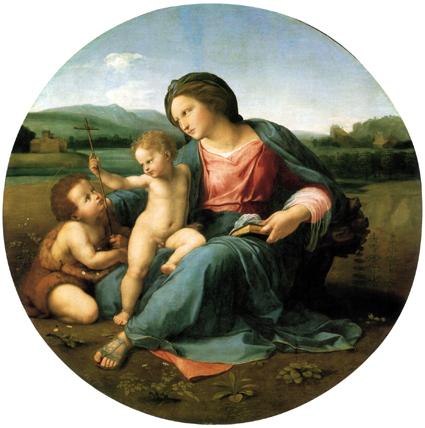To mark the Sunday before Christmas Day, this week’s picture is a beautiful circular painting of the Virgin and Child with St John by the Renaissance master Raphael – a work commonly known as the Alba Madonna. The painting is owned by the National Gallery of Art in Washington but is currently on display at the National Gallery in London, as part of “Raphael: From Urbino to Rome”, an engrossing exhibition which charts the young painter’s precocious charge from Umbrian obscurity into the limelight of papal Rome.
The picture is undated but most art historians believe that Raphael painted it sometime between 1509 and 1511, when he was also at work on his frescoes of The School of Athens and The Disputa for the Stanza della Segnatura, Pope Julius II’s library in the Vatican apartments. The Alba Madonna is a breathtakingly beautiful work of art, all the more impressive since recent restoration work brought back the original, delicate pastel colours used by the artist, and revealed the subtle depth and brilliancy of the landscape background. The buildings on the hilltop at the right-hand edge of the composition are caught by a raking light and have been misted by varying degrees of haze to create the illusion of relative distance from the eye – a technique known as aerial perspective. The far mountains are similarly hazed by distance to a rich azure, while the sky above varies in colour from Wedgewood blue, at its apex, to a cool milky-white on the horizon. This range of colours is repeated in the folds and shadows of the Madonna’s blue robes, which at once echo and animate the circular shape of the composition. A monumental, comforting figure, clothed in robes that look as if woven from a piece of fallen sky, she...


